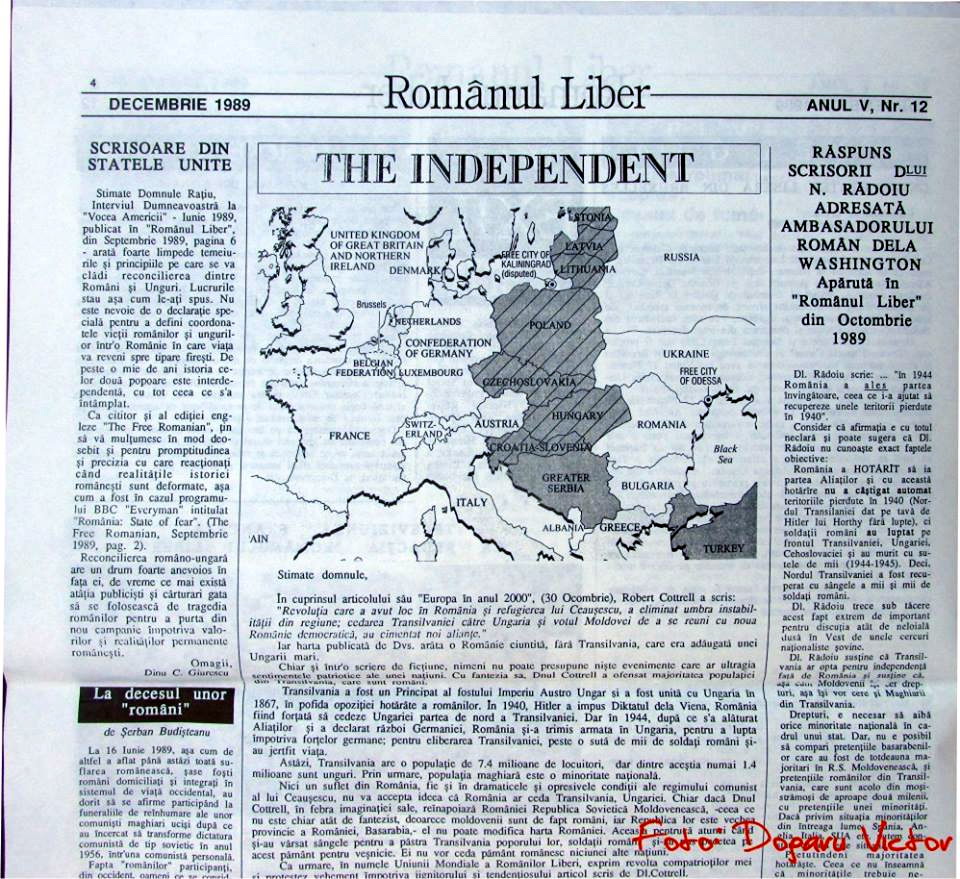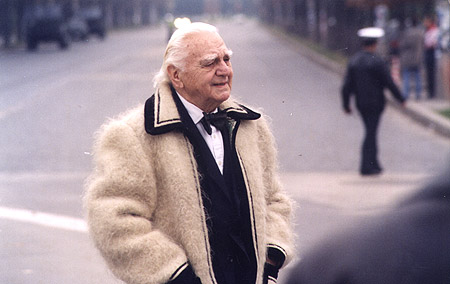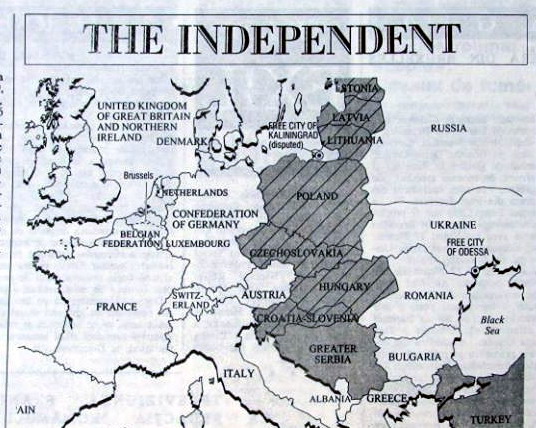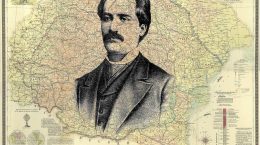 Cercetătorul Victor Dogaru scoate la lumină un protest al regretatului Ion Raţiu, publicat în decembrie 1989 în ziarul său, Românul liber, faţă de un articol “futuristic” apărut în cotidianul britanic The Independent sub semnătura lui Robert Cottrell, pe 30 octombrie 1989, în care, pe lângă fuga lui Ceauşescu în urma unei revoluţii era “prezisă” şi noua configuraţie a Europei în anul 2000. Conform planurilor maghiare “milenare”, Transilvania era plasata, din nou, în Ungaria, ceea ce a provocat reacţia vehementă a patriotului ţărănist. Raţiu protestase cu aceeaşi energie românească şi împotriva revizionistei “Declaraţii de la Budapesta”, alcătuită de răposatul Mihnea Berindei pe catafalcul rămăşiţelor bolşevicului Imre Nagy, reînhumat cu fast la Budapesta pe 16 iunie 1989 şi semnată, printre alţii, şi de Regele Mihai, istericul Dan Alexe, ex-curierul trădător Neagu Djuvara şi alte personulităţi.
Cercetătorul Victor Dogaru scoate la lumină un protest al regretatului Ion Raţiu, publicat în decembrie 1989 în ziarul său, Românul liber, faţă de un articol “futuristic” apărut în cotidianul britanic The Independent sub semnătura lui Robert Cottrell, pe 30 octombrie 1989, în care, pe lângă fuga lui Ceauşescu în urma unei revoluţii era “prezisă” şi noua configuraţie a Europei în anul 2000. Conform planurilor maghiare “milenare”, Transilvania era plasata, din nou, în Ungaria, ceea ce a provocat reacţia vehementă a patriotului ţărănist. Raţiu protestase cu aceeaşi energie românească şi împotriva revizionistei “Declaraţii de la Budapesta”, alcătuită de răposatul Mihnea Berindei pe catafalcul rămăşiţelor bolşevicului Imre Nagy, reînhumat cu fast la Budapesta pe 16 iunie 1989 şi semnată, printre alţii, şi de Regele Mihai, istericul Dan Alexe, ex-curierul trădător Neagu Djuvara şi alte personulităţi.

Ion Ratiu: “Declaraţia a făcut un mare deserviciu istoriei şi chiar viitorului poporului român.”
“Fără îndoială, vasta majoritate a poporului român nu poate să adopte o astfel de poziţie şi să-şi nege originea. Şi e absolut sigur că românul ardelean, fără excepţie, o respinge.
Declaraţia, însă, a făcut un mare deserviciu istoriei şi chiar viitorului poporului român.
E prima dată când un grup de români a recunoscut implicit că Transilvania nu e pământ românesc, că ne-am format acolo împreună cu ungurii.” – scria Ion Raţiu în protestul său public, reprodus în „Românul liber” (Londra), în septembrie 1989.
Iată că peste numai o lună de la acest prim protest, “aspiraţiile” semnatarilor “Declaraţiei de la Budapesta” sunt înfăţişate grafic, într-o harta “futuristică” dintr-un mare cotidian britanic. Coincidenţă (a se citi cu aceeaşi pronunţie ca celebrul “Ghinion”).
“Revoluţia care a avut loc în România şi refugierea lui Ceauşescu a eliminat umbra instabilităţii din regiune; cedarea Transilvaniei către Ungaria şi votul MOldovei de a se reuni cu noua Românie democratică, au cimentat noi alianţe”, scria jurnalistul “futurolog” Robert Cottrell în octombrie 1989.
“Nici un suflet din România, fie şi în dramaticele şi opresivele condiţii ale regimului comunist al lui Ceauşescu, nu va accepta ideea că România va ceda Transilvania, Ungariei.”, transmitea Ion Raţiu editorului The Independent, în numele Uniunii Mondiale a Românilor Liberi,explicându-i şi că “moldovenii sunt de fapt români” (aviz amatorilor).
Reproducem la rândul nostru harta şi consideraţiile lui Ion Raţiu (foto sus), pentru că obsesiile umede ale statului extremist ungar, considerat, pe bună dreptate, un magar troian în NATO şi UE, nu au încetate nici azi. De asemenea, din imaginaţia lui Robert Cottrell dezlănţuită în The Independent, reluăm în original o sinteză şi câteva fraze elocvente. (V.R.)
“Europe in the year 2000”

No, the title’s right but before you ask if I have gone into reverse gear, this is the headline from a feature in The Independent by Robert Cottrell published on 30 October 1989 – after the protests had started in the GDR but before the opening of the Berlin Wall.Cottrell tried to imagine how the changes of 1989 would look ten years later, and the result is the somewhat indistinct map at the top of this post. At the centre of the map is a united “Confederation of Germany”. The Baltic States are independent and together with Poland, Czechoslovakia, Hungary, a federation of Croatia and Slovenia, “Greater Serbia” and Turkey are associate European Community members (all but Greater Serbia and Turkey with their currencies pegged to the DM). The Soviet Union has disappeared, to be replaced in Europe by Russia and Ukraine. In western Europe, the Nordic countries and Austria joined the EC in the mid-1990s, after the “Delors Convention” moved the currencies of European Monetary System onto fixed parities supervised by a European System of Central Banks (in effect, national currencies have become non-decimal divisions of a single European currency) leaving only Switzerland “truly immune to the charms of monetary union, and [which] prospered mightily as Europe’s sole remaining tax haven”. Belgian has more or less ceased to be a unitary state and instead is a federation of Flanders and Wallonia.Cottrell’s imagination – from before the opening of the Berlin Wall – saw a revolution in Romania, and the flight of the Ceausescus; a move to a German Confederation in 1995 (still a hopelessly ambitious timetable according to some of Cottrell’s contemporaries from 1989); the break up of Yugoslavia into a federation of Croatia and Slovenia, and a Greater Serbia; and – even – the restitution of Transylvania to Hungary. The Baltic states become “miracle economies”, flooded with foreign investment and technology, akin to the “Asian tigers”; Poland is a source for cheap labour; while the biggest loser is “Russia” itself, the exhaustion of whose Communist Party led to an apparently unsuccessful military coup, with a United Front government surviving on aid from the West terrified by its arsenal of military weapons (remember this was envisioning Europe in 2000 and Cottrell might not have been so far of the mark). Germany’s “armed neutrality” and the withdrawal of US troops (presumably the Soviet troops have also been pulled back) effectively end NATO’s battlefield role, though NATO provides nonetheless “a useful diplomatic forum”.True, he does not predict the break up of Czechoslovakia, nor the wars that accompanied the break up of Yugoslavia, but from the fictional perspective of 2000, Cottrell writes:
LONDON – 31 December 1999. The end of a momentous decade. The commentators who spoke of the “death of history” in the 1990s had to concede its resurrection in the 1990s: not as a struggle between ideologies, but as a struggle for identity. Atavism re-entered the mainstream of Europe’s politics.
Behind all this “futurology”Cottrell’s point is that it is the European Community that would be the true magnet of the reshaping of Europe and the central point of a post-1989 settlement:
Can we fix upon an event, a date at which the “old” Europe began subverting the new? It might, for instance, have been the birth 20 years ago [in 1980] of Polish Solidarity, later to mount the first successful challenge to a Soviet satellite government; or the demands for independence by the Baltic states; or the visit of Mikhail Gorbachev to East Berlin in 1989, the spark which set the fire under the old guard of the Socialist Unity Party and thus cleared the way towards the German Confederation. But these were the punctuation marks rather than the message itself. It would be truer, if less picturesque, to see the weaknesses of the post-war settlement as having been inherent in its creation … To the extent that the European Community was conceived as a yoke around the German neck, pulling it into line with its more placid neighbours, it failed: the relationship has been almost precisely reversed. But in other ways the EC has proved a much greater success than its founding six might have imagined.
Sursa: Holy Disorder via Ziaristi Online




